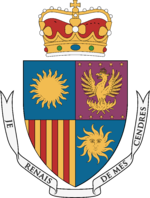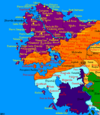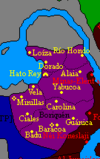Government and politics of Nouvelle Alexandrie

|
This article or section is a work in progress. The information below may be incomplete, outdated, or subject to change. |
The Federation of Nouvelle Alexandrie is a federation governed within the framework of a parliamentary democracy under a constitutional monarchy in which the monarch, currently King Sinchi Roca, is the head of state while the President of the Government (also known as the “Premier”), currently Paolo Antonio Aguilar (since 1718 AN) of the Federal Humanist Party, is the head of government.
Executive power is exercised by the Council of State of Nouvelle Alexandrie on behalf of and by the consent of the King and by the regional governments of the 12 Regions. After the King and the President of the Government, the Council of State of Nouvelle Alexandrie is the most important executive government body, composed of the Premier and Vice-President of the Government, Cabinet Secretaries, and other government officials.
Legislative power is vested in the two chambers of the Cortes Federales of Nouvelle Alexandrie, the Federal Assembly and the Chamber of Peers, as well as in the regional legislatures of the 12 Regions of the Federation.
The judiciary of Nouvelle Alexandrie is independent of the executive and the legislature. The highest court is the High Court of Justice. The independent judiciary is based upon the civil law system which evolved from the codes of law of Alexandria, Caputia, and Natopia. The New Alexandrian judiciary also includes various bodies that check abuses of government power and other independent agencies.
Nouvelle Alexandrie’s political system is a multi-party system. During the early years of the Federation, regional and national parties would unite into grand coalitions or political unions, often of a temporary nature, to achieve power and have a majority in the Federal Assembly. The first elected Government of Nouvelle Alexandrie was a Government of National Unity, composed of the Federal Humanist Party, Cambio Democratico, and the Diggers' Society. However, over the years, there has been much political consolidation in New Alexandrian politics. Many of the smaller parties have merged with larger ones and others have dissolved as political energy shifted to other parties and movements. Parties like Cambio Democratico, the Diggers' Society, and many others eventually dissolved and gave way to new movements, independent candidacies, and parties. Currently, four political parties have representation in the Cortes Federales. The Cortes are currently dominated by two large parties: the Federal Humanist Party, a center-right party, and the Federal Consensus Party, a centrist-liberal party. The Social Democratic & Liberal Alliance, a center-left party, was once consistently the second largest party (having won the majority in the elections of 1703 and governed until 1708 AN), until the election of 1718, where it plummeted to third place and had its worst showing in history. The smallest party in the Cortes is the libertarian People's Liberty Congress. There is a strong tradition in New Alexandrian politics of maintaining independent candidacies and members of the legislature, with almost every session of the Cortes seeing independents play a key role, even creating political movements and new parties. This tradition has made independent candidacies common, especially for views or causes that do not find an immediate home in any of the current political parties.
The constitution of the Federation of Nouvelle Alexandrie is the Proclamation of Punta Santiago. The Proclamation serves as both the founding document of the Federation and its central constitutional charter. The Proclamation has been revised and amended several times to fit the needs and make changes to the terms of governance of the Federation by the Federal Constituent Assembly in the years leading up to the 1693 constitutional referendum. After the ratification of the final version of the Proclamation of Punta Santiago by the Federal Constituent Assembly in 1693 AN, the 1693 constitutional referendum approved the Proclamation as the law of the land and approved the establishment of the Federation of Nouvelle Alexandrie (changing the nation's name from Alduria-Wechua) by large margins. These referenda were followed by the 1693 general elections to elect the first Cortes Federales.
The Federation is also responsible for one territory, called Jaris. Formerly known as Ijubicastagrad, Jaris is considered an “outremer territory”, meaning an area directly controlled by the national government that is not considered "incorporated" for the purposes of federal law. This territory is established as "unincorporated territory" under the direct rule of the King or to another legally incorporated body "on behalf or in commission of the King". In the absence of an organic law (a lawful regional or local constitution or charter) approved by the Cortes Federales, a territory is classified as unorganized. Selected constitutional provisions apply, depending on legislative acts and judicial rulings according to the constitutional practice, local tradition, and law of Nouvelle Alexandrie.
Political parties and pressure groups
Nouvelle Alexandrie boasts a dynamic political scene, characterized by the interplay of multiple political parties and pressure groups. The political parties, which span across the ideological spectrum, offer diverse policy platforms and are vital to the functioning of the nation's parliamentary system. Among the numerous organizations or pressure groups, those focused on issues such as business, labor, environmental protection, human rights, and economic reform wield significant influence in shaping public opinion and policy.
| Federal Party | Logo | Color | Seats | Political Wing | Ideology |
|---|---|---|---|---|---|
| Federal Consensus Party | 
|
Sky Blue Green |
326 / 689 |
Center to center-left (Big tent party) |
|
| Federal Humanist Party | 
|
Black Gold Purple |
196 / 689 |
Center-right to right-wing (Big tent party) |
|
| Alliance for a Just Nouvelle Alexandrie | Red White |
111 / 689 |
Center-left to left-wing (Big tent party) |
| |
| Liberty and Prosperity Alliance | 
|
Dark Blue Gold Red |
39 / 689 |
Center-right to libertarian |
|
| Unaligned / Independents |
17 / 689 |
Constitution
The Proclamation of Punta Santiago is the supreme law of the land, and it outlines the fundamental principles upon which the Federation is founded. This document enshrines the rights and liberties of the citizens, defines the structure and powers of the government, and provides the guiding framework for the operation of the regional and local governments. The document also serves as the official founding document of the nation, proclaiming the purpose and values of the Federation.
Executive branch
Government
The Council of State of Nouvelle Alexandrie comprises the Premier, the Vice-Premier, and various Department Secretaries. It is responsible for implementing national laws, overseeing the administration of government departments and agencies, and guiding the nation's domestic and foreign policies.
Legislative branch
The Cortes Federales of Nouvelle Alexandrie is the bicameral legislature of Nouvelle Alexandrie, consisting of the Federal Assembly and the Chamber of Peers. It is vested with the power to make laws, scrutinize the government's work, and represent the interests of the citizens.
Federal Assembly
The Federal Assembly of Nouvelle Alexandrie is the lower and most powerful house of the Cortes Federales. Its members are called Deputies, and they are elected by the citizens of the Federation to represent their interests and pass legislation on their behalf.
Chamber of Peers
The Chamber of Peers of Nouvelle Alexandrie, the upper house of the Cortes Federales, comprises of the Grandees and nobles of the Federation; religious clergy appointed by the King from the Nazarene, Bovic, Melusinian, and other faiths of the Federation; and other esteemed experts and academics from various sectors of society. It functions primarily as a revising chamber, reviewing and suggesting amendments to legislation passed by the Federal Assembly.
Judicial branch
Judicial courts
The Judiciary of Nouvelle Alexandrie is an independent branch of government, with the High Court of Justice at its apex. It has the power to interpret the Proclamation of Punta Santiago, adjudicate legal disputes, and ensure that all actions of the government are lawful.
Ombudsman
The Ombudsman of Nouvelle Alexandrie is an independent officer of the Cortes Federales, tasked with investigating complaints from citizens about maladministration by government officials or agencies. The Ombudsman provides an important check on the executive's power and helps to ensure the rights of citizens are protected.
New Alexandrian law
Basic principles
New Alexandrian law is primarily based on the civil law system and is characterized by written codes of law. Its principles evolved from the legal codes of Alexandria, Caputia, and Natopia. The system is built around upholding the rule of law, protecting the rights and liberties of individuals, and ensuring that justice is served in a fair and transparent manner.
Local government
Nouvelle Alexandrie is divided into 12 Regions, each with its own regional government. These governments are responsible for managing local affairs and implementing regional policies. They also play a crucial role in the delivery of public services to the citizens.




































